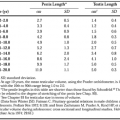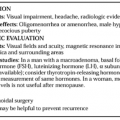PROGNOSIS OF NONTOXIC GOITER
Part of “CHAPTER 38 – NONTOXIC GOITER“
In young or middle-aged patients, particularly those with non-toxic gland enlargement due to Hashimoto thyroiditis, goiter may remit spontaneously. Goiter due to severe Hashimoto thyroiditis is thought to lead to progressive thyroid atrophy (“remission of goiter”) and eventual hypothyroidism. Mild thyroiditis usually has no metabolic sequelae. As many as one-third of autonomous (“warm” or “hot”) solitary nodules may remit spontaneously (“burn out”).52
The natural course of nontoxic goiter, however, ordinarily is further enlargement of the gland and the appearance of benign nodularity, estimated at 4.5% increase in size annually.53 Indeed, even normal thyroids, over the life span, often develop micronodularity or macronodularity. Except in the case of patients who have received low-energy head-and-neck irradiation, the risk of development of thyroid carcinoma in a nontoxic goiter is low (<1%). The overall risk of thyroid cancer in patients who have had head-and-neck irradiation may be as high as 8%.54 As indicated earlier, long-term follow-up of patients with large nontoxic goiter reveals a strong incidence (33%) of development of thyrotoxicosis. The rate of hyperthyroidism in patients with previously nontoxic goiter depends on duration of follow-up, for example, 15% at 12 years55 compared with the higher incidence cited earlier at 30 years. Thus, the prognostic spectrum of nontoxic goiter is broad, and the histopathology is usually benign.
Stay updated, free articles. Join our Telegram channel

Full access? Get Clinical Tree






